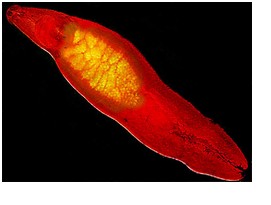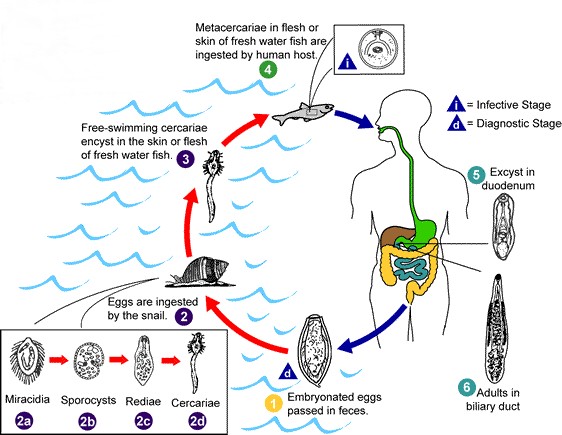

 Infection by the liver fluke parasite is a major health concern for millions of people, specifically those living in the Far East, Eastern Europe, and Southeast Asia. In addition, because of the large amount of travel between countries, liver fluke infection is becoming more prominent in areas where the disease has not previously been found, such as in North America. There are several kinds of medical conditions that people infected by the parasite may experience, each dependent on the kind of parasite that has embedded itself into its host.
Infection by the liver fluke parasite is a major health concern for millions of people, specifically those living in the Far East, Eastern Europe, and Southeast Asia. In addition, because of the large amount of travel between countries, liver fluke infection is becoming more prominent in areas where the disease has not previously been found, such as in North America. There are several kinds of medical conditions that people infected by the parasite may experience, each dependent on the kind of parasite that has embedded itself into its host.
Symptoms include vomiting, nausea, loss of appetite, abdominal pain, fatigue, rashes, swollen liver, fever and muscle pain.
Once inside of the snail body, the miracidium hatches from the egg, and parasitically grows inside of the snail. The miracidium develops into a sporocyst, which in turn house the asexual reproduction of redia, the next stage. The redia themselves house the asexual reproduction of free-swimming cercaria. This system of asexual reproduction allows for an exponential multiplication of cercaria individuals from one miracidium. This aids the Clonorchis in reproduction, because it enables the miracidium to capitalize on one chance occasion of passively being eaten by a snail before the egg dies.
Once the redia matures, having grown inside the snail body until this point, they actively bore out of the snail body into the freshwater environment.
There, instead of waiting to be consumed by a host (as is the case in their egg stage), they seek out a fish. Boring their way into the fish's body, they again become parasites of their new hosts. Once inside of the fish muscle, the cercaria create a protective metacercarial cyst with which to encapsulate their bodies. This protective cyst proves useful when the fish muscle is consumed by a human.
Definitive host
The acid-resistant cyst enables the metacercaria to avoid being digested by the human gastric acids, and allows the metacercaria to reach the small intestine unharmed. Reaching the small intestines, the metacercaria navigate toward the human liver, which becomes its final habitat. Clonorchis feed on human bile created by the liver. In the human liver, the mature Clonorchis reaches its stage of sexual reproduction. The hermaphroditic adults produce eggs every 1-30 seconds, resulting in the rapid multiplication of inhabitants in the liver.
Effects on human healthDwelling in the bile ducts, Clonorchis induces an inflammatory reaction, epithelial hyperplasia and sometimes even cholangiocarcinoma, the incidence of which is raised in fluke-infested areas.
One adverse effect of Clonorchis is the possibility for the adult metacercaria to consume all bile created in the liver, which would inhibit the host human from digesting, especially fats. Another possibility is obstruction of the bile duct by the parasite or its eggs, leading to biliary obstruction and cholangitis (specifically oriental cholangitis).
Central Serous Retinopathy (CSR) a report of 80 cases by Dr. John Chiao-nan Chang, M.D. and Dr. Yin-Ping Wang, M.D. Hong Kong on page 125 of their report observed that 19% of the cases of CSR in their sample tested positive for Clonorchis sinensis.]

Infection by the liver fluke parasite and possible consequences
by Brent Miesse
Recently I was ask, "Do you really feel that parasites are causing much of today's illnesses?" It took me just a moment to respond. You see for the past few months I personally have been suffering from a rash, an affliction that I am presently resolving. Then I got an email asking me about a non-alcoholic fatty liver. I began to research this condition. The more I researched it, the more I realized I was experiencing some of these same symptoms. Fatigued, itching of the hands and feet and eventually entire body, mental confusion, weight issues, rash, red palms ...
Could it be it I ask myself? Then I read about the clonorchic sinesis....a fluke parasite that invades the human body through the digestive track. It is estimated that 30,000,000 humans are infected by this parasite (mostly in Asia but because of the large amount of travel between countries, liver fluke infection is becoming more prominent in areas where the disease has not previously been found, such as in North America).
Found in the muscle of fish this parasite creates a cyst which encapsulates its body. Once ingested by humans this encapsulation protects the fluke from the HCI acids in the stomach. Once in the digestive tract it makes its way to the liver. After it is in the liver it thrives on the bile produced by the liver causing inflammation in the liver.
This inflammation causes the liver cells to release enzymes into the blood. Liver enzyme counts increase because of the inflammation. Eventually the liver may become fatty because of its non ability to process the fats.
We know that 70% of larger Americans have a fatty liver. This little critter feeds on the bile from the liver and creates a situation where your digestive track does not function properly. Eventually the liver will not break down fats as designed by our creator.
Could this be the reason that so many Americans today are carrying so much fat in the blood stream?
Could this be the reason that so many have tried their hardest to rid themselves of fat and are overweight?
Could it be the cause of those who are constantly hungry?
Could it be the reason for so many kidney issues since the liver can no longer rid the body of toxins, over tasking the kidneys?
Could it be one of the reasons for hot flashes since the liver is responsible for getting rid of excess hormones?
Could it cause pancreatitis since if a fluke blocks the bile duct then the fluid from the pancreas has no where to go, causing inflammation of the pancreas.
Could this be a reason why so many are affected by diabetes?
Could lymph glands be affected from the excessive load of toxins in the blood stream?
Without the bile is it not true that constipation along with malnutrition could take place?
This might be the most valuable piece of information that you have ever come across. An issue that could lead to better health in so many aspects of your biological functions. So what can we do?
First we need to take a look at the problem and at the same time work to get rid of the issue causing the problems. So let's work on the parasite and the symptoms, all at the same time....
|
|
|
|
Parasites elimination
Pumpkin and Winter Squash Seeds (a good idea to help get rid of parasites)
Take your pumpkin or squash seeds and allow them to dry. Then mix them with olive oil and sea salt and bake at 350 degrees for 20 min. Great snack high in zinc and omega 3 that will also rid your body of parasites.
|